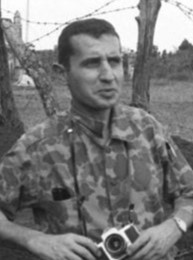- Note: The "François Sully" credited in The Foreman Went to France (1942) was British character actor Francis L. Sullivan. [1]
François Sully | |
|---|---|
 Sully in 1965 | |
| Born | 27 August 1927
Paris, France |
| Died | 24 February 1971 (aged 43) |
| Nationality | French |
| Occupation | Journalist |
François Sully (1927–1971) was a French journalist and photographer best known for his work during the Vietnam War. Sully was one of the earliest journalists to cover the Vietnam War and spent 24 years in Indochina. At the time of his death in a command helicopter crash near the Cambodian border, he was viewed as the dean of the Saigon press corps.
Life
Sully was born on 27 August 1927 in France and fought against the Nazis in the French Resistance as a teenager and was wounded on his seventeenth birthday in Paris. After the liberation of Paris he enlisted in the French Army, fought the Nazis in Germany and then volunteered for the French Expeditionary Forces, arriving in Saigon when the Japanese surrendered in 1945. Discharged in Saigon, Sully tried his hand as a tea planter and rancher before turning to journalism. In 1947 he joined Sud-Est Asiatique, a now defunct French magazine, working for them until 1953. He was assigned to cover the battle of Dien Bien Phu by Time-Life. He escaped from behind the Viet Minh lines. In 1959 he joined United Press International (UPI). He wrote articles for Time magazine and his photographs were carried by Black Star until he joined Newsweek in early 1961.
In March 1962, Sully was to be expelled from South Vietnam by President Ngo Dinh Diem, egged on by Madame Nhu, as his reporting was deemed "helpful to the enemy". Unofficially, Diem intended the expulsion to serve as a warning to all journalists reporting the failings of his U.S.-assisted war against the Viet Cong. The other journalist on the expulsion list was Homer Bigart of the New York Times. Diem backed down after the U.S. Mission explained that expulsion would only worsen an already bad relationship with the press. Five months later, however, in August 1962, Sully was sent packing after some seventeen years in Indochina. The Newsweek issue of August 20, 1962 carried a long article by Sully "Viet Nam: The Unpleasant Truth". His expulsion became a major political affair between Saigon and Washington. Sully departed Saigon on September 9, with most of the press corps at the airfield in a show of solidarity. After his expulsion Sully proceeded to Harvard where he put in a year at the Nieman Foundation and worked in bordering countries to Vietnam. He returned to the Newsweek bureau in Saigon after the November 1963 Coup and assassination of Ngo Dinh Diem.
During his work as Newsweek's Saigon Bureau Chief, Sully also wrote for a number of other newsmagazines including The Nation and The New Republic. In 1967 and 1968, Sully wrote articles for McGraw-Hill's business-reporting service World News which distributed them to Business Week, Medical World News, Engineering News Record, and other publications. In addition to writing news stories and taking photographs, Sully wrote Age of the Guerrilla: The New Warfare (New York: Parent's Magazine Press, 1968; reprinted by Avon, 1970) and compiled and edited We the Vietnamese: Voices from Vietnam (New York: Praeger, 1971).
Sully was the insider's insider amongst the press corps in Vietnam. His sources were numerous inside the Viet Minh and Viet Cong, inside the Palace in Saigon and at grassroots levels in every province in the North and South. He spoke several languages and was fluent in French, English, Vietnamese and Lao.
Sully died in late February 1971. On 23 February 1971 he was aboard the command helicopter of General Do Cao Tri (the 'Patton of the Parrots Beak') as it turned west towards Cambodia. The helicopter had lifted off from Tay Ninh airstrip and was heading towards a firebase just across the Vietnam-Cambodia border. [2] As the helicopter was nearing its destination it burst in flames. Sully alone leaped from the burning craft and plunged 75 feet (23 m) to the ground, all others died in the crash. Sully died from injuries suffered in the fall at Long Binh hospital. [3] Sully was buried in Mac Dinh Chi Cemetery in Saigon. [4] He left his insurance policy of 18 million piasters (equivalent to $45,000 at February, 1971 exchange rates) to Vietnamese orphans.[ citation needed]
See also
References
- ^ ""The Foreman Went to France"". Archived from the original on 2009-03-21. Retrieved 2009-03-07.
- ^ Fulghum, David; Maitland, Terrence (1984). The Vietnam Experience South Vietnam on Trial: Mid-1970–1972. Boston Publishing Company. p. 61. ISBN 0939526107.
- ^ "The Death of a Fighting General | TIME". 2007-04-29. Archived from the original on 2007-04-29. Retrieved 2024-01-23.
- ^ "Tet and remembrance of the dead", International Herald Tribune, February 28, 2005
Further reading
- Grant, Zalin. Facing the Phoenix: The CIA and the Political Defeat of the United States in Vietnam. W. W. Norton & Co., 1991. ISBN 978-0-393-02925-3
- "François Sully". Newsweek, September 17, 1962, p. 68
- "François Sully". Newsweek, March 8, 1971, p. 75
External links
- Francois Sully papers and photographs, 1958-1983, University Archives and Special Collections, Joseph P. Healey Library, University of Massachusetts Boston
- Francois Sully Collection, William Joiner Center, UMass Boston.
- Francois Sully, The Newseum.
- "Sully, François, 1927-1971 : Papers and photographs, 1958-198 (Bulk, 1963-1971)", Sully Collection at WGBH Open Vault.
- 1927 births
- 1971 deaths
- Nieman Fellows
- French planters
- Historians of the Vietnam War
- Burials at Mac Dinh Chi Cemetery
- Journalists killed while covering the Vietnam War
- War photographers killed while covering the Vietnam War
- 20th-century French historians
- French male writers
- French military personnel of World War II
- French Resistance members
- 20th-century French journalists